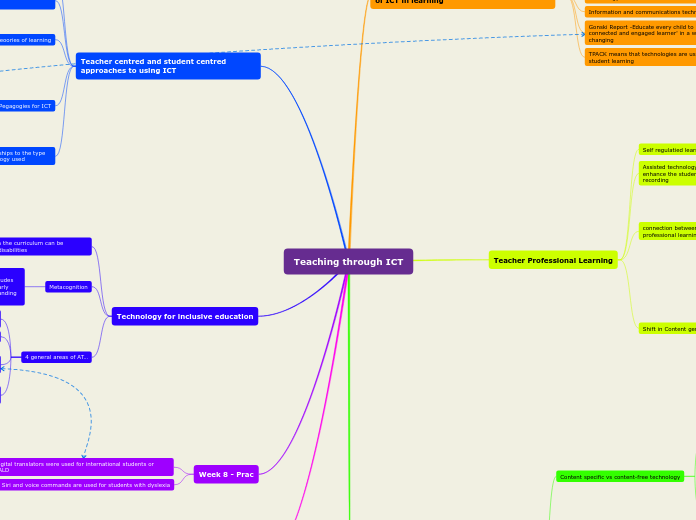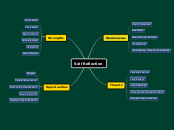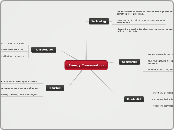Teaching through ICT
Week 9 - Prac
In technology class they learnt coding and programming, which is becoming very important to know for their future careers and daily life
Apps such as Reading eggs and Mathletics are used to practise skills they have learnt in class
Week 8 - Prac
Siri and voice commands are used for students with dyslexia
Digital translators were used for international students or EALD
Technology for inclusive education
4 general areas of AT…
Access technologies to enable students to engage with the curriculum
Example: alternative keyboards, alternative mouses, interactive systems, virtual reality
Supportive technologies to improve efficiency within learning episodes
transforming content
Written content may need to be transformed before student can effectively engage with the text
Three step process:
1. Create digital copy
2. Recognize content (OCR)
3. Place digital content to an appropriate digital format for the student
Example: Print to speech: Prizmo
Handwriting recognition: Pen to Print
Print to speech pens: C-Pen
Framework applications to cater to learning needs
Curriculum applications to enhance learning in a specific curriculum focus
Metacognition
metacognition is thinking about thinking and learning processes. Employing metacognition when studying includes planning, monitoring and evaluating your efforts, regularly assessing and adjusting your methods and the understanding being gained (or not gained).
descriptors/requirements within the curriculum can be manipulated to assist learning disabilities
We can make appropriate adjustments in assessment tasks to allow the student to respond. However you need to ensure that they meet the curriculums intent
special provisions do not involve compensating for what the student does not know or cannot do.
Examples:Signing instead of speaking
Computer simulation instead of lab work
Specialised equipment (e.g. keyboard, rather than handwriting)
Additional time to complete tasks
Teacher centred and student centred approaches to using ICT
What teachers believe/ theories has relationships to the type of pedagogy and to the type of tools/technology used
Types of Pegagogies for ICT
Teacher- Centered approach (powerpoint)
Remember knowledge
tell students or ask them to look up facts i.e looking up facts about a history event and writing and essay
Student- Centred approach (working together)
collaborate, exploration and knowledge (actively constructing their learning). Their choice to inquire into a subject
Create knowledge
Theoories of learning
Constructivist/Constructionist
the children put the content in and they evaluate it
Pedagogy that is needed for Constructivist approach is Projects, big questions, investigation
Software that assists the learning of the child in a constructivist learning spreadsheets, content-free, Educreation/ShowMe App
Behaviourist/Cognogist
knowledge exists external to the child and could be transmitted and received
software used is a tutorial programs
follows the pedagogy direct instruction
Effective assessment is not a copy and paste activity i.e interview for a biography
Think and apply instead of copy and paste
use technology tools to activate the children learning instead copy and pasting information (passive learning) for exploring, creating, collaborative learning
The questions you ask (yes/no, factual, big) can affedt the use of the ICT and pedagogy
The role of Computer Games in learning and Reading
. “Almost two-thirds of students want to use digital games for learning in school…53% say they have received better grades by using technology within learning.” (p. 267, Prestridge, S & Finger, G, 2017).
pedagogical practises
Teacher Centred/ Student Centred
Primarily- teacher centred
Mix- balanced
Primarily Student Centred
Pedagogical practices with ICT
Conjectual
enables students to manipulate ideas and hypotheses to develop knowledge
Revelatory activities/knowledge in order for students to discover the concept
Instructional
divides the learning activities into smaller units with use of positive/negative feedback for corrections
Epistemic beliefs
Relativism: that knowledge is uncertain and
based on the weight of accumulated evidence
Relativistic: most knowledge as tentative and contextual and generated by the self;
Multiplistic: multiple views but still believe that most knowledge is certain
Dualistic: right-or-wrong knowledge handed down by authority
Student should learn how to use technology that is needed so daily life.
“We are still woefully short of classroom environments that permit students to engage with technology in a way that prepares them to use technology in the real world” (Ertmer, P. A., Ottenbreit-Leftwich, A. T., Sadik, O., Sendurur, E., & Sendurur, P, 2012).
Basic to more complex ways to use technologies ( how?)
Ertmer's reading - role that teachers assign technology
Enrich (add to existing practise)
Augment the existing curriculum where ICT is considered a tool for teaching content, collaboration, higher order thinking
Transform (change it)
Leverage opportunities for transformation practices with ICT where new ways of working with ICT driven by students equally with curriculum requirements
Relate to the conventions collaborate, compute, curate, create
Supplement (same same)
supplement the curriculum for productivity outcomes such as using ICT to motivate, reinforce or practise subject skills
Content specific vs content-free technology
Content- free software
consideration is needed for where the technology is located
Students - hands
Teachers - hands
Constructivist - view of learning
students have to do something in this space
Software or increments that are blank/empty and can be applied to any content/ subject domain
content specific software
they are underpinned by Behaviourist- cognitivist- views of learning
they do not teach children
Correct answers are rewarded and incorrect answers are remediated
computer programs/games or tutors that demonstrate information incrementally with questions to be answered by the learner
Teacher Professional Learning
Shift in Content generation for professional learning
Shift content generation to the teacher it is facilitating that role of professional learning to the teacher
twitter, facebook, pinterest, youtube, blogs
this also assists in cost limitations as it allows other ideas for lesson plans
this assists with singular teachers of a subject as it allows them to discuss and receive ideas from other teacher
based on self-action/ inquiry into the classroom
teachers are generating the content
School based learning to online course work
Both domains are provided by an outside expert
connection between professional development and professional learning
another way is the teacher as pedagogical experts then they direct their professional learning - professional need and interest
teacher directed approach to their professional learning
natural/serendipitous study work performed by teachers in the class that they discuss online
not formally planned by the school
traditional approaches to professional development is conceptualised that teachers need direct instruction about how to improve their skills and strategies
planned by the school
Profesional developement is being done to teachers
Assisted technology is for all stusdents as the technologies can enhance the students capabilities such as note taking and recording
position it at the students level where they are in control of the devices
Self regulatied learning
time management, metacognition, effort regulation, peer learning, critical thinking
Rationalising and conceptualising the role of ICT in learning
TPACK means that technologies are used in ways that enhance student learning
Gonski Report -Educate every child to be a 'creative, connected and engaged learner' in a world that is constantly changing
Information and communications technology = ICT
to appropriately use the TPACK framework teaches must incorporate and manipulate their pedagogical technique and technology
The definition of technology can be argue such as everything that is artificial or new items that were released after your birth
Technological pedagogical and content knowledge (TPACK): A theory that explains the knowledge that educators have in order to educate their students effectively through technology.









